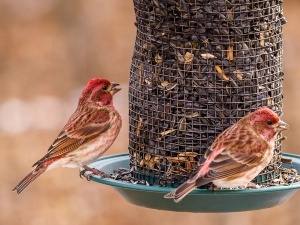
Feeding birds is a noble thing to do, songbirds will be happy to eat from your bird feeder if you leave bird food out for them.
Unfortunately, the bigger bully birds may bully out the smaller songbirds keeping them from feeding. This article looks at how to keep big birds away from bird feeders.
Table of Contents
How to keep big birds away from feeders:
Many people maintain bird feeders as a way to keep smaller birds, like songbirds, on their property, unfortunately, bigger birds, like starlings, grackles, and blackbirds will be attracted to your feeder as well. This is how to keep these big birds away:
Use a cage around your feeder:
If you’re wanting to keep using your current feeder, but want to keep bigger birds away from it, then you can try installing a cage around the feeder.
Choose a cage that is large enough to let your smaller birds through, giving them access to the feeder, but not large enough to where larger birds can get in.
The gaps in the cage should be big enough to where the smaller birds can fit their whole body, or head, in and access the feeder.
Make sure that your big bully birds can not fit their head, neck, and body through the cage.
You can also wrap wire around your bird feeder. Make the spaces between the wire big enough to where the beaks of smaller birds can get in but the beaks of the larger birds cannot.
Use an upside-down suet feeder
Acrobatic birds (which are usually smaller birds) can feed from upside-down suet feeders, smaller birds like chickadees, and grackles are acrobatic birds.
Larger birds, like grackles, are not able to feed from an upside-down suet feeder. If you’re wanting to keep bigger birds away then using an upside-down suet feeder is one solution
Get rid of your mounted bird dish
Mounted bird dishes attract all types, and sizes, of birds. These dishes are securely attached to the structure that they are mounted on, this is great for bigger birds but not for you.
Get rid of these large mounting dishes to keep bigger birds from visiting your garden and eating up the bird feed. The larger birds will realize that there is nowhere available for them to rest and eat, and they will eventually stop visiting.
Use tube feeders:
Not all birds can eat out of tube feeders, and this is a good thing. Because these feeders have a small perch under the feeding port, these feeders only have room for small birds to rest and feed.
Birds like titmice, grosbeaks, finches, sparrows, and chickadees can use these feeders but these won’t be able to accommodate larger birds.
Use a dome feeder
A dome feeder is another type of feeder that will keep bigger birds from accessing your bird feed. Dome feeders have a feeder dish at the bottom, where the bird feed is placed, and a dome on top.
There is a gap between the dome and the feeder dish, this gap is large enough to where small birds can enter, rest and feed. Larger birds can’t get into this gap to feed and will thus be excluded.
Use different seed
Different birds prefer different seeds. Make your birdfeeder attractive to only smaller birds by only filling the feeder up with seeds that they prefer.
Larger birds enjoy eating corn, millet, bread, wheat, and sunflower seeds, do not fill your bird feeders with these.
Keep your smaller birds around by filling your feeders with thistle seeds/nyjer seed, this will attract finches, also fill your feeder with safflower seeds, these will attract nuthatches, cardinals, and chickadees.
Offer bigger birds their own feeders
You can keep bigger birds away from feeders meant for smaller birds by giving them their own feeder and filling this up with the feed that they like, also make sure that these feeders are easy for bigger birds to access.
Fill this feeder up with foods that they enjoy including wheat, corn, millet, sunflower seeds, and peanut. Make sure that you place this feeder a distance from the feeder meant for your smaller birds.
Use weight-activated feeders:
Weight-activated feeders can be used to keep large birds, as well as squirrels, away from your small bird’s feed.
These feeders are designed to open when there is no weight, or when there is very little weight, on the leaver. The weight of a small bird will keep the feeder open and allow the bird to eat.
When a larger bird, or a squirrel, tries to access the feeder, the weight of the bird, or squirrel, will cause the feeder to shut off automatically.
The feeder will open again when the bird, or squirrel, leaves. This device gives smaller and lighter birds the opportunity to feed.
If you enjoyed this article then you may also be interested in other bird related articles. Here are some articles that you may be interested in: How To Stop Pigeons From Laying Eggs, How To Scare Pigeons With Sound, Signs Your Bird Is Going To Lay An Egg, Why Do Birds Eat Other Birds?, Why Are Pigeon Nests So Bad?,

